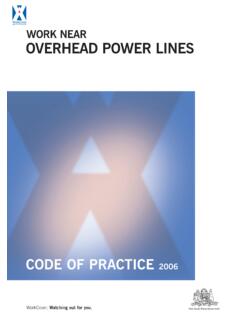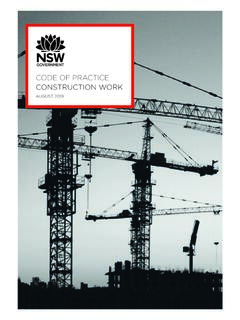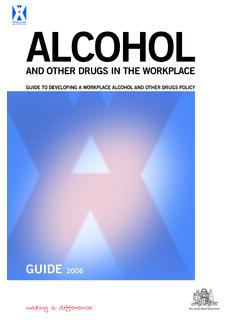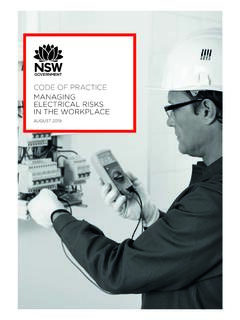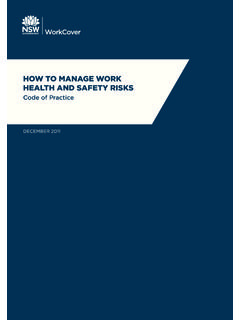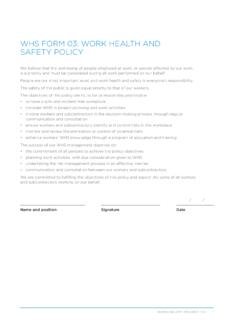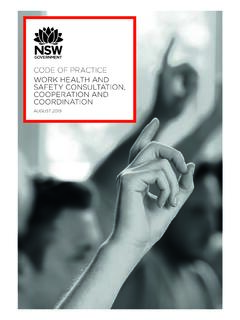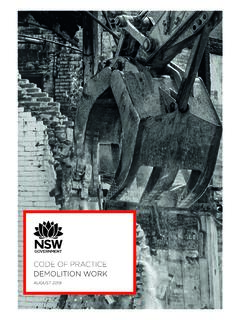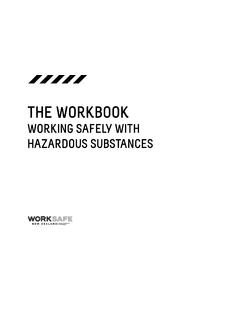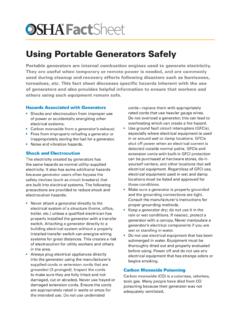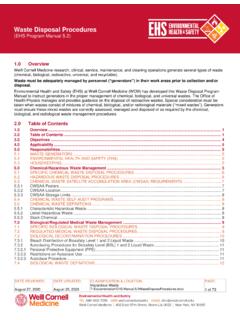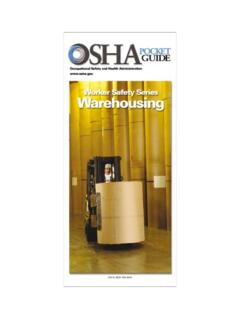Transcription of Guide for Unpacking Shipping Containers - SafeWork NSW
1 Guide FOR Unpacking Shipping CONTAINERSSAFEWORK NSWOCTOBER 2016 DisclaimerThis publication may contain information about the regulation and enforcement of work health and safety in NSW. It may include some of your obligations under some of the legislation that SafeWork NSW administers. To ensure you comply with your legal obligations you must refer to the appropriate on the latest laws can be checked by visiting the NSW legislation website publication does not represent a comprehensive statement of the law as it applies to particular problems or to individuals or as a substitute for legal advice. You should seek independent legal advice if you need assistance on the application of the law to your material may be displayed, printed and reproduced without amendment for personal, in-house or non-commercial No. SW08344 SafeWork NSW, 92 100 Donnison Street, Gosford NSW 2250 Locked Bag 2906, Lisarow NSW 2252 | Customer Service Centre 13 10 50 Website 978 1 74341 383 8 Copyright SafeWork NSW 1117 CONTENTSI ntroduction 4 Risk management 5 Key principles for safe Unpacking 5 Packing by the supplier 6 Placement of the container for unloading 7 What is the issue?
2 7 How can I manage this? 7 Before opening the container 8 What is the issue? 8 How can I manage this? 8 Before you unpack the container 9 What is the issue? 9 How can I manage this? 9 Unpacking 10 What is the issue? 10 How can I manage this? 10 More information 12 Acknowledgements 134 SafeWork NSWINTRODUCTIONThis Guide provides you with information on how to manage health and safety risks when Unpacking Containers transported by land or sea. From the opening of the container doors, through to removing and transporting items to the storage location the Guide covers your obligations under work health and safety key hazards associated with Unpacking Shipping Containers include: Containers placed on sloping or uneven ground inadequate lighting to allow safe Unpacking of the container contents loose items due to inadequate securing to prevent movement during transport items not packed for easy Unpacking , not on pallets or slip sheets loose items falling from a height items that can come loose during transport forcing the doors open or falling on workers when the door is first opened unsafe systems employed to unpack Containers , such as.
3 Selecting unsuitable straps, chains or restraints or using them incorrectly incorrectly using plant to unpack the container , for example, using a forklift not designed to tow to drag items out of container overloading plant, and not taking the rated capacities of attachments into consideration having people working in and around the container and being hit by mobile plant used for removing items not providing information about the items being handled, such as the item s weight or whether it is hazardous ignoring potential risk of exposure to chemicals used for fumigation of the container conducting manual tasks that require lifting heavy items, bulky items or situations which require the worker to use awkward postures ignoring the risk of slips, trips and falls not being aware of how to manage chemical spillage inside the Guide does not address the loading of Containers , related traffic management, handling dangerous goods in Containers and packing items into Containers .
4 For details of these topics refer to More information chapter of this publication is for all those legally responsible for health and safety when Unpacking Shipping Containers . Those with legal duties include employers, contractors, labour hire agencies, freight forwarders, consignors, customers and employees. For details of these legal duties refer to More information chapter of this FOR Unpacking Shipping CONTAINERSRISK MANAGEMENTA safe and healthy workplace does not happen by chance or guesswork. You have to think about what could go wrong at your workplace and what the consequences could be. Then you must do whatever is reasonably practicable to eliminate or minimise health and safety risks arising from your business or manage risks, you must first identify all potential hazards associated with Unpacking Shipping Containers , assess them where necessary, and then eliminate the hazards so far as is reasonably practicable.
5 If it is not reasonably practicable to eliminate this hazard, the risk must be controlled in accordance with the hierarchy of controls . The controls should be subject to the requirements of what is reasonably practicable .It is not always necessary to conduct an assessment, especially if the risks and effective control measures are already known. For example, choosing a forklift to remove pallet loads. In deciding how to control risks you must consult your workers and their representatives who will be directly affected by this decision. Their experience will help you choose appropriate control measures and their involvement will increase the level of acceptance of any changes that may be needed to the way they do their your control measures from time to time to ensure they are working as planned and remain items packed in Containers vary significantly, small, large, heavy, light and bulky.
6 Therefore, the management of associated risks also will vary from one container to another. For details of risk management refer to the More Information chapter of this PRINCIPLES FOR SAFE Unpacking Always establish a plan for safe Unpacking before doing anything else. If the load has shifted or appears precarious or unsafe, don t enter the container . Never allow workers inside the container if there is any risk of objects moving and trapping them. Never allow workers inside the container if there is a chemical spill. Never allow people and mobile plant to operate inside Containers at the same time. Avoid working alone inside Containers . Continue to assess the load for risks as you unpack. If conditions change, don t risk it. Stop, conduct a risk assessment and replan the work taking all reasonable precautions. Never stand near a load that is unsecured.
7 For example, sheet material on an A-frame. Where practicable, use mechanical aids over manual handling. For example, a conveyor. Ensure workers who are Unpacking Containers are trained, supervised and competent. This will help them to select the right work processes that have the lowest risk, choose appropriate equipment and know when to call for assistance if safety is unclear or jeopardised. Ask for help if you don t have the equipment or expertise to safely unpack a container . If necessary engage specialists to do the Unpacking . Ensure workers wear appropriate PPE when emptying the NSWPACKING BY THE SUPPLIERThe best way to plan for safe Unpacking is to work with the supplier to ensure: the load is packed to prevent or minimise items becoming loose or unstable during transport. This may be achieved by placing them on racks, crates, wrapping, strapping or a combination of these goods are packed on pallets or slip-sheets to enable the use of a forklift to unload.
8 Bulk bags may also be appropriate each load of sheet material is individually secured on an you have the facilities to unpack Containers from the top, ask your supplier to use open top Containers to avoid entering the container for Containers that allow access from both ends will also help you to avoid entering the container and enable the of use dual lifts to remove bulky or long your supplier for a packing plan that includes a list of items, the weights of items, where items are placed in the container and how the items are restrained. This information will help you develop a safe system of work for Unpacking prior to the container arriving on site. Figure 1: Example of a packing plan showing where items are placed in the FOR Unpacking Shipping CONTAINERSPLACEMENT OF THE container FOR UNLOADINGWHAT IS THE ISSUE?Placement of a container in an inadequate location onsite can lead to a number of risks including: electrocution slips, trips and falls falls from height collision of people and plant physical fatigue musculoskeletal disorders risk of being hit by unrestrained items or falling loads.
9 HOW CAN I MANAGE THIS?The risk of injuries arising from the placement of the container can be eliminated or significantly reduced by: consulting with workers who will be Unpacking the container consulting with other site users prior to placement of the container on common property considering the proposed container site prior to its arrival, including the path of navigation to its resting place. For example, are there obstacles, overhead power lines or any other dangers? selecting a suitable area for Unpacking on level undamaged ground with sufficient space to open doors and provide safe access paying close attention to the stability of the container if it is positioned at a height to access a loading dock. You should consider lowering the landing leg of the trailer to sure this up ensuring the site has adequate space to operate plant in and around the container and to set down a load outside of the container (this should be considered in your Traffic Management Plan) ensuring there is sufficient lighting in and around the container for Unpacking and operating plant considering the environmental conditions of the site, for example, heat, rain and ventilation; and the appropriateness for workers Unpacking in these 2: Ensure the container is placed on even NSWBEFORE OPENING THE CONTAINERWHAT IS THE ISSUE?
10 Loads within a container often shift during transportation or may move as a result of inadequate packing. Goods may be pushing against container doors. This can lead to uncontrolled opening of the doors. Workers are at risk of being hit by unrestrained items or falling loads. HOW CAN I MANAGE THIS?The risk of injuries arising from the opening the container can be eliminated or significantly reduced by: never assuming the load is secured in a safe manner when you are opening a container door using a suitable restraint, such as a short rope, net or barrier, on the door to prevent the items resting on the doors from forcing the doors open without a control in place opening the right hand door cautiously first, only when safe, proceed with the left checking to see if the goods have shifted when the doors are partially opened consulting with workers to develop and implement a safe method of Unpacking (using a safe work method statement) if the goods have shifted checking for any notices or labels (such as dangerous goods labels), or notices concerning the contents.
